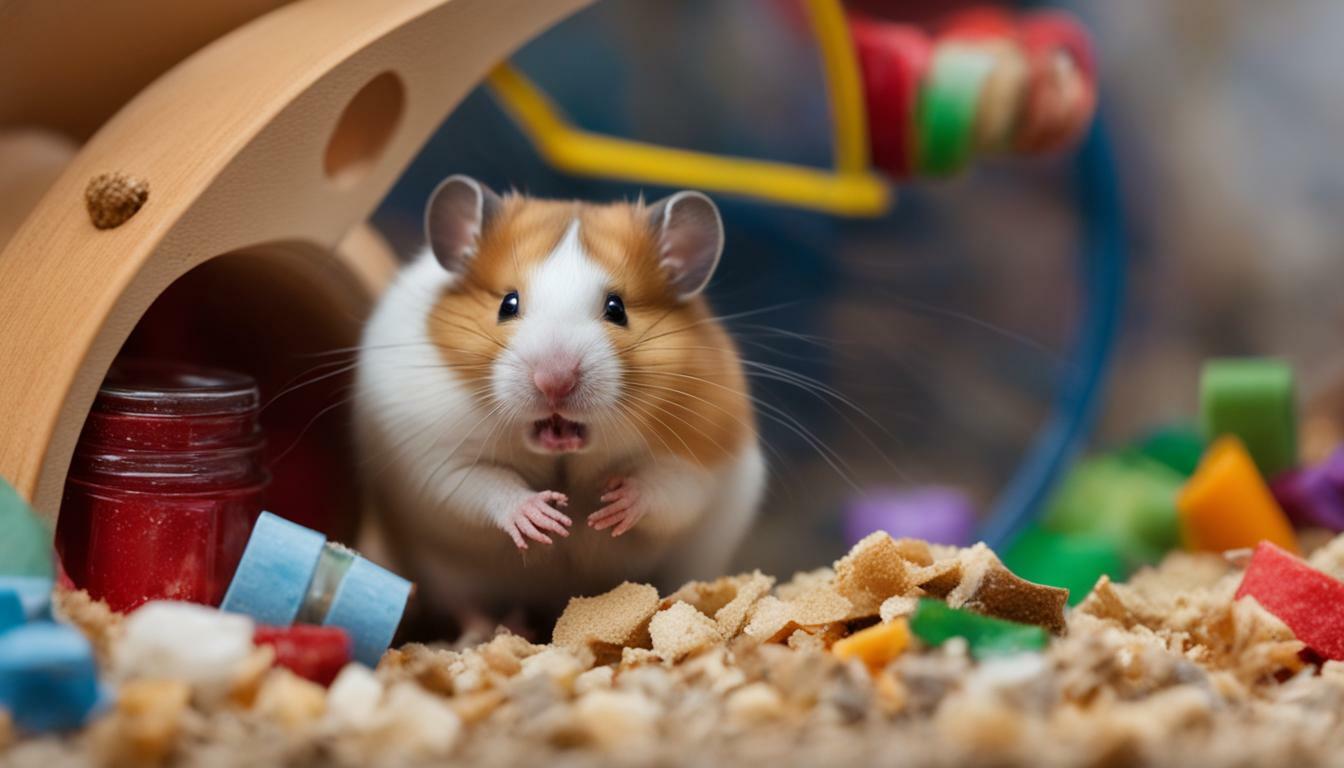If you’ve ever wondered whether hamsters sneeze, you’re not alone. Let’s delve into the fascinating world of hamster behavior and find out!
Key Takeaways:
- Hamsters can sneeze due to allergies, dust, or respiratory infections.
- Continued sneezing or signs of a cold require immediate veterinary help to prevent pneumonia.
- Cleaning the cage, changing bedding, and ensuring proper ventilation can help alleviate sneezing.
- A clean and suitable habitat, free from drafts and contaminated water, is essential for hamster health.
- Antibiotics may be prescribed by a veterinarian to manage cold symptoms in hamsters.
Understanding Hamster Sneezing
Hamster sneezing can be triggered by a range of factors, including allergies and respiratory infections. Let’s take a closer look at these causes.
Allergies are a common cause of hamster sneezing. Just like humans, hamsters can have allergic reactions to various substances, such as dust, pollen, or certain types of bedding. When a hamster is exposed to an allergen, it can lead to irritation in their respiratory system, resulting in sneezing.
Respiratory infections are another potential cause of hamster sneezing. Bacterial or viral infections can affect a hamster’s respiratory tract, leading to inflammation and excessive mucus production. This can cause sneezing as the hamster’s body tries to clear out the irritants.
How to Identify the Causes of Sneezing in Hamsters
It’s important to be observant and look for other accompanying symptoms when your hamster is sneezing. If you notice your hamster has a runny nose, watery eyes, or if they appear lethargic or have decreased appetite, it could indicate a respiratory infection. On the other hand, if your hamster only sneezes occasionally and doesn’t show any other signs of illness, it may be due to allergies.
| Possible Causes of Hamster Sneezing | Accompanying Symptoms |
|---|---|
| Allergies | Occasional sneezing, no other symptoms |
| Respiratory Infection | Runny nose, watery eyes, lethargy, decreased appetite |
If you are unsure about the cause of your hamster’s sneezing or if their condition worsens, it is best to consult a veterinarian. They can provide a proper diagnosis and recommend appropriate treatment options.
Frequency of Hamster Sneezing
It’s important to understand how often hamsters sneeze and what signs to watch for in order to ensure their well-being. Let’s explore the frequency and signs of sneezing in hamsters.
Hamsters, like humans, can experience sneezing from time to time. It is a common behavior for them and can occur for various reasons. Sneezing in hamsters can be triggered by allergies, dust, or even upper respiratory infections. While occasional sneezing is generally nothing to worry about, persistent or excessive sneezing may indicate an underlying issue that requires attention.
So, how often do hamsters sneeze? The frequency of sneezing can vary between individual hamsters. Some may sneeze more frequently than others, especially if they are exposed to allergens or have respiratory conditions. It is important to monitor your hamster and look out for signs of discomfort or distress alongside the sneezing. These signs may include a runny nose, watery eyes, or changes in behavior. If you notice any of these symptoms, it is crucial to seek veterinary help immediately.
To help alleviate sneezing caused by allergies or respiratory infections, there are several steps you can take. Firstly, ensure that your hamster’s habitat is clean and suitable. Regularly change the bedding and clean the cage to minimize dust and allergens. Proper ventilation is also important, as it can help prevent the buildup of irritants in the air. Additionally, avoid exposing your hamster to drafts and provide them with clean, uncontaminated water. Taking these precautions can help reduce the risk of excessive sneezing and promote your hamster’s overall well-being.
| Signs of a Sneezing Hamster |
|---|
| • Sneezing episodes occurring frequently, especially if accompanied by other symptoms like a runny nose or watery eyes |
| • Changes in behavior, such as decreased appetite or lethargy |
| • Appearance of discharge from the nose or eyes |
Dealing with a Sneezing Hamster
If your hamster is sneezing, you might be wondering how to help them. In this section, we’ll discuss ways to treat a sneezing hamster and whether sneezing is a normal occurrence for these small pets.
Sneezing in hamsters can be caused by various factors, including allergies, dust, or upper respiratory infections. If you notice that your hamster is sneezing frequently or exhibits other signs of a cold, such as a runny nose or watery eyes, it’s important to seek veterinary help immediately. Colds in hamsters can quickly turn into pneumonia, which can be deadly for these tiny creatures.
While there is no cure for the common cold in hamsters, there are steps you can take to alleviate sneezing caused by allergies or respiratory infections. Start by changing the bedding in your hamster’s cage, as dust or irritants in the old bedding may be triggering the sneezing. Regularly cleaning the cage and ensuring proper ventilation can also help reduce allergens and improve air quality, providing relief for your hamster.
It’s equally important to maintain a clean and suitable habitat for your hamster. Avoid exposing them to drafts, as sudden temperature changes can result in sneezing. Additionally, make sure to provide fresh, uncontaminated water for your hamster, as drinking from a dirty water source can also cause sneezing and other health issues.
| Ways to Treat a Sneezing Hamster |
|---|
| 1. Seek veterinary help if sneezing persists or other cold symptoms occur. |
| 2. Change bedding regularly to reduce allergens. |
| 3. Clean the cage frequently and ensure proper ventilation. |
| 4. Avoid exposing your hamster to drafts. |
| 5. Provide fresh, uncontaminated water. |
If your hamster’s sneezing does not improve or if additional symptoms develop, consult a veterinarian for accurate diagnosis and appropriate treatment. They may prescribe antibiotics to manage the symptoms and help your hamster recover. Remember, early intervention is key in ensuring the well-being of your furry friend.
Preventing Hamster Sneezing
Taking preventative measures can go a long way in keeping your hamster from sneezing. Let’s explore some effective tips for preventing hamster sneezing.
1. Keep a clean habitat: Regularly cleaning your hamster’s cage is essential to prevent sneezing caused by dust or allergens. Use safe, non-toxic bedding materials and clean the cage at least once a week. This helps maintain a healthy environment for your furry friend.
2. Ensure proper ventilation: Good airflow in the hamster’s environment helps reduce the chances of respiratory issues and sneezing. Avoid placing the cage in a drafty area and provide adequate ventilation to keep the air fresh and clean.
3. Avoid exposure to triggers: Hamsters can be sensitive to certain substances, such as perfumes, smoke, and cleaning products. Avoid using strong scents near your hamster’s cage and opt for mild, unscented cleaning solutions. Additionally, make sure their water is clean and free from contaminants.
4. Seek veterinary help: If your hamster continues to sneeze or exhibits signs of a cold, such as watery eyes or a runny nose, it is crucial to seek veterinary assistance promptly. Colds can quickly progress into pneumonia in hamsters, which can be life-threatening. A veterinarian can provide the necessary treatment and advice to help manage the symptoms.
| Preventive Tips | Description |
|---|---|
| Clean the cage regularly | Prevents dust and allergens from accumulating |
| Ensure proper ventilation | Reduces the risk of respiratory issues |
| Avoid exposure to triggers | Perfumes, smoke, and cleaning products can irritate the hamster’s respiratory system |
| Seek veterinary help | Prompt medical attention is crucial if sneezing persists or cold symptoms worsen |
Importance of a Clean Habitat
Providing a clean and suitable habitat is essential for the overall well-being of your hamster. Let’s dive into the importance of maintaining a clean cage and choosing the right bedding.
Your hamster’s cage is their safe haven, and keeping it clean is crucial to their health. Regular cleaning helps remove accumulated waste, food particles, and potentially harmful bacteria. It also minimizes odors and prevents the growth of mold and other allergens that could trigger your hamster’s sneezing. When cleaning the cage, make sure to use hamster-safe cleaning products and avoid any harsh chemicals that may harm your pet.
In addition to regular cleaning, choosing the right bedding is essential. Opt for bedding materials that are dust-free and hypoallergenic, as dust and allergens can irritate your hamster’s respiratory system and lead to sneezing. Avoid cedar or pine shavings, as they can release harmful chemicals that may negatively affect your hamster’s health. Opt for bedding made from paper, hay, or aspen, which are safer options for your furry friend.
| Benefits of a Clean and Suitable Habitat |
|---|
| Prevents respiratory issues |
| Reduces the risk of allergies |
| Minimizes odors |
| Creates a comfortable living environment |
By maintaining a clean habitat and choosing the right bedding, you can significantly reduce the chances of your hamster sneezing due to allergies or respiratory infections. Remember to clean the cage regularly and provide a fresh supply of bedding for your hamster to burrow and nest in. Your furry friend will appreciate the clean and cozy environment, and you’ll enjoy watching them thrive in their habitat.
Ensuring Proper Ventilation
Adequate ventilation is key to maintaining a healthy environment for your hamster. Let’s learn more about the importance of proper airflow and how it relates to preventing sneezing.
Hamsters are prone to sneezing caused by allergies or respiratory infections. An enclosed or poorly ventilated habitat can trap allergens like dust, mold, or pet dander, triggering sneezing and other respiratory issues. To ensure your hamster breathes clean air, it is essential to provide proper ventilation in their living space.
One way to promote good airflow is by choosing a cage with appropriate ventilation holes. These holes allow fresh air to circulate while preventing drafts. Additionally, regularly cleaning the cage will help remove any accumulated dust or allergens. Use a mild, hamster-safe disinfectant and ensure thorough drying before putting your furry friend back in their home.
Another useful tip is to keep the hamster’s habitat away from areas with excessive moisture or strong odors. Moist environments can promote the growth of mold and bacteria, which can irritate your hamster’s respiratory system. Similarly, strong odors from cleaning products or cooking can be overwhelming for their sensitive noses, leading to sneezing or discomfort.
| Preventing Sneezing in Hamsters | Importance of Proper Ventilation |
|---|---|
| Regularly clean the cage to remove dust and allergens. | Allows fresh air to circulate, reducing the risk of respiratory issues. |
| Avoid exposing your hamster to drafts or excessive moisture. | Prevents the growth of mold and bacteria that could trigger sneezing. |
| Choose a cage with appropriate ventilation holes. | Ensures proper airflow without creating drafts. |
| Keep the hamster’s habitat away from strong odors. | Reduces the risk of respiratory irritation. |
If your hamster continues to sneeze or shows signs of a cold, such as a runny nose or watery eyes, it is important to seek veterinary help immediately. Colds can quickly turn into pneumonia, which can be deadly for hamsters. While there is no cure for the common cold in hamsters, a veterinarian may prescribe antibiotics to help manage the symptoms and prevent secondary infections.
By prioritizing proper ventilation and creating a clean and suitable habitat for your hamster, you can help prevent sneezing caused by allergies or respiratory infections. Remember to monitor your hamster’s health closely, provide regular veterinary check-ups, and make their well-being a top priority.
Avoiding Drafts and Contaminated Water
Your hamster’s health can be impacted by drafts and contaminated water, leading to sneezing and other respiratory issues. Let’s explore how to keep your furry friend safe from these concerns.
Avoiding Drafts:
- Place your hamster’s cage in a draft-free area of your home, away from windows, doors, and air vents.
- Check for any gaps or cracks in the cage that may allow drafts to enter. Seal these areas with appropriate materials.
- Avoid placing the cage near fans or air conditioning units, as the direct airflow can cause discomfort for your hamster.
Avoiding Contaminated Water:
- Provide fresh, clean drinking water to your hamster daily. Ensure that the water is free from any impurities or contaminants.
- Use a water bottle or dispenser specifically designed for hamsters to prevent contamination from bedding or debris.
- Regularly clean and disinfect the water bottle or dispenser to maintain hygiene.
Summary:
By avoiding drafts and providing clean water, you can help prevent respiratory issues and sneezing in your hamster. Keep their cage in a draft-free area, seal any gaps or cracks, and avoid placing the cage near direct airflow. Additionally, ensure your hamster has access to fresh, uncontaminated drinking water by using a suitable dispenser and regularly cleaning it. These simple measures will contribute to a healthier and happier hamster.
| Avoiding Drafts | Avoiding Contaminated Water |
|---|---|
| Place the cage in a draft-free area | Provide fresh, clean drinking water |
| Seal gaps or cracks in the cage | Use a hamster-specific water bottle or dispenser |
| Avoid placing the cage near fans or air conditioning units | Regularly clean and disinfect the water dispenser |
Seeking Veterinary Help
If your hamster is sneezing persistently or displaying symptoms of a cold, it’s important to seek veterinary help. In this section, we’ll highlight the importance of timely medical assistance and the potential risks involved.
Hamsters can sneeze for various reasons, including allergies, dust, or upper respiratory infections. While occasional sneezing may not be cause for alarm, persistent or excessive sneezing could indicate a more serious underlying issue. If left untreated, colds in hamsters can rapidly progress to pneumonia, which can be deadly for these small creatures.
When your hamster is showing signs of sneezing and cold-like symptoms, such as a runny nose or watery eyes, it’s crucial to consult a veterinarian experienced in small animal care. A professional will be able to assess your hamster’s condition, provide an accurate diagnosis, and recommend appropriate treatment options.
In some cases, your veterinarian may prescribe antibiotics to help manage the symptoms and prevent further complications. It’s important to follow their guidance closely and administer any prescribed medication as directed. Additionally, they may offer advice on how to create a clean and suitable habitat for your hamster, which can help alleviate sneezing caused by allergies or respiratory infections.
Table: Signs to Look Out for in a Sneezing Hamster
| Signs | Description |
|---|---|
| Excessive sneezing | Frequent and uncontrollable sneezing episodes |
| Runny nose | Nasal discharge that is clear or cloudy in appearance |
| Watery eyes | Eyes that appear teary or have excessive moisture |
Remember, early intervention is key when it comes to hamster health. Seeking veterinary help at the first signs of sneezing can help prevent the worsening of symptoms and potentially save your hamster’s life. By providing the necessary medical attention, you can ensure your furry friend receives the best possible care.
Managing Cold Symptoms
While there is no cure for the common cold in hamsters, there are ways to manage the symptoms. Let’s delve into the possible treatment options and supportive care for hamsters with cold symptoms.
Firstly, if your hamster continues to sneeze or shows other signs of a cold, such as a runny nose or watery eyes, it is crucial to seek veterinary help immediately. Hamsters are highly susceptible to respiratory infections, and colds can quickly progress to pneumonia, which can be deadly. A veterinarian will be able to assess the severity of the cold and provide appropriate treatment.
In terms of supportive care, there are several steps you can take to alleviate your hamster’s discomfort. Changing the bedding frequently and ensuring a clean and suitable habitat is essential. Regular cage cleaning helps remove any potential allergens or irritants that may contribute to sneezing. Additionally, proper ventilation is crucial to maintain good airflow and prevent respiratory issues. Avoid exposing your hamster to drafts, as they can worsen cold symptoms.
| Treatment Options | Pros | Cons |
|---|---|---|
| Antibiotics | – Can help manage bacterial infections – Prescribed by a veterinarian |
– May not be effective against viral infections – Can cause side effects in some hamsters |
| Supportive Care | – Maintain a warm and stress-free environment – Provide plenty of fresh water and nutritious food |
– Does not directly treat the cause of the cold – Some hamsters may require additional medical intervention |
It’s important to note that antibiotics may be prescribed by a veterinarian to help manage the symptoms of a cold in hamsters. However, antibiotics are not effective against viral infections, which are a common cause of colds. Supportive care, including maintaining a warm and stress-free environment, providing plenty of fresh water, and offering nutritious food, can help bolster your hamster’s immune system and aid in their recovery. Additionally, ensuring your hamster receives regular check-ups and vaccinations can help prevent respiratory infections.
Remember, if your hamster is showing signs of a cold or persistent sneezing, prompt veterinary attention is crucial. By providing proper care and a comfortable environment, you can help alleviate their symptoms and support their overall well-being.
Conclusion
Hamsters can indeed sneeze for various reasons, and it’s important for their owners to understand the potential causes and how to address them. In this article, we have explored the question of whether hamsters sneeze and delved into the reasons behind this common behavior. From allergies to respiratory infections, we have discussed the different factors that can lead to hamster sneezing.
If your hamster continues to sneeze or shows signs of a cold, such as a runny nose or watery eyes, it is crucial to seek veterinary help immediately. Colds can quickly turn into pneumonia, which can be deadly for hamsters. Your veterinarian will be able to provide the necessary care and treatment to ensure your furry friend’s well-being.
Changing bedding, cleaning the cage regularly, and ensuring proper ventilation can help alleviate sneezing caused by allergies or respiratory infections. Maintaining a clean and suitable habitat for your hamster is essential for their overall health. Additionally, it is important to avoid exposing them to drafts or contaminated water, as these can also trigger sneezing episodes.
While there is no cure for the common cold in hamsters, antibiotics may be prescribed by a veterinarian to help manage the symptoms. Providing supportive care and ensuring your hamster stays comfortable will aid in their recovery. Remember to always consult with a professional if you have any concerns about your hamster’s health.
FAQ
Do hamsters sneeze?
Yes, hamsters can sneeze for various reasons, including allergies, dust, or upper respiratory infections.
What are the reasons for hamster sneezing?
Hamsters can sneeze due to allergies, dust, or upper respiratory infections.
How often do hamsters sneeze?
The frequency of hamster sneezing can vary, but if your hamster continues to sneeze or shows signs of a cold, it’s important to seek veterinary help immediately.
How do I deal with a sneezing hamster?
If your hamster is sneezing, changing the bedding, cleaning the cage, and ensuring proper ventilation can help alleviate the sneezing. If the symptoms persist, it’s best to consult a veterinarian.
How can I prevent hamster sneezing?
To prevent hamster sneezing, it’s important to provide a clean and suitable habitat for your hamster. This includes regular cage cleaning, using proper bedding, and avoiding potential triggers such as drafts and contaminated water.
Why is a clean habitat important for hamsters?
A clean habitat is crucial for hamsters’ health as it helps prevent respiratory issues and allergies that can cause sneezing. Regular cage cleaning and proper bedding choices contribute to a healthy environment for your furry friend.
How can I ensure proper ventilation for my hamster?
Proper ventilation is essential for hamster health. Make sure there is good airflow in the hamster’s habitat to prevent sneezing caused by allergies or respiratory infections.
How can I avoid drafts and contaminated water?
To avoid drafts, place your hamster’s habitat away from windows or doors that may let in cold air. It’s also important to provide clean and uncontaminated water to prevent potential triggers for sneezing.
When should I seek veterinary help for my sneezing hamster?
If your hamster continues to sneeze or shows other signs of a cold, such as a runny nose or watery eyes, it’s important to seek veterinary help immediately as colds can quickly turn into pneumonia and be deadly for hamsters.
How can I manage cold symptoms in my hamster?
While there is no cure for the common cold in hamsters, antibiotics may be prescribed by a veterinarian to help manage the symptoms. It’s best to consult a vet for appropriate guidance and treatment options.




